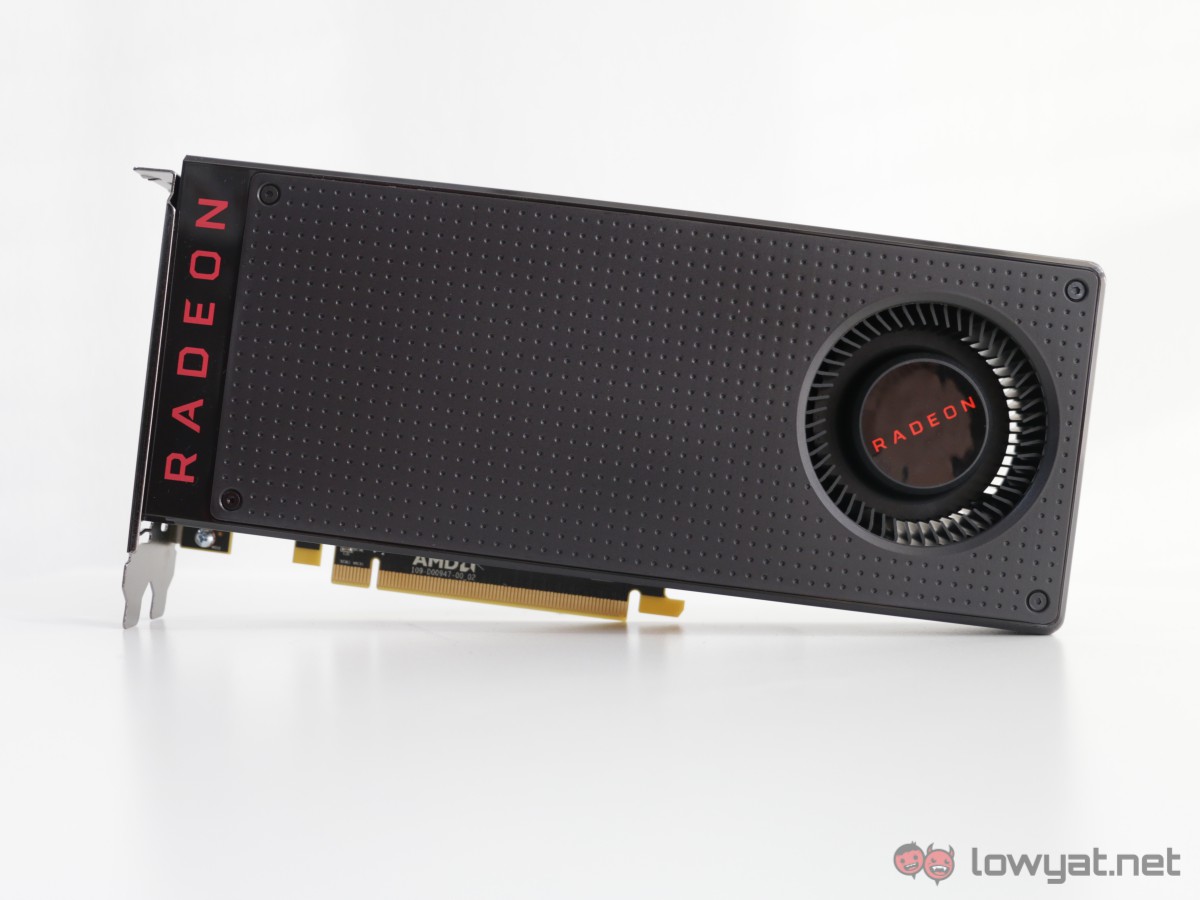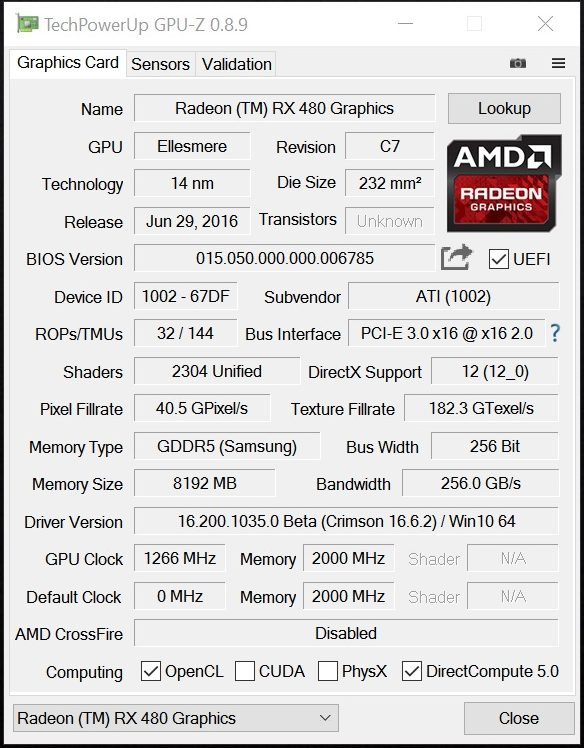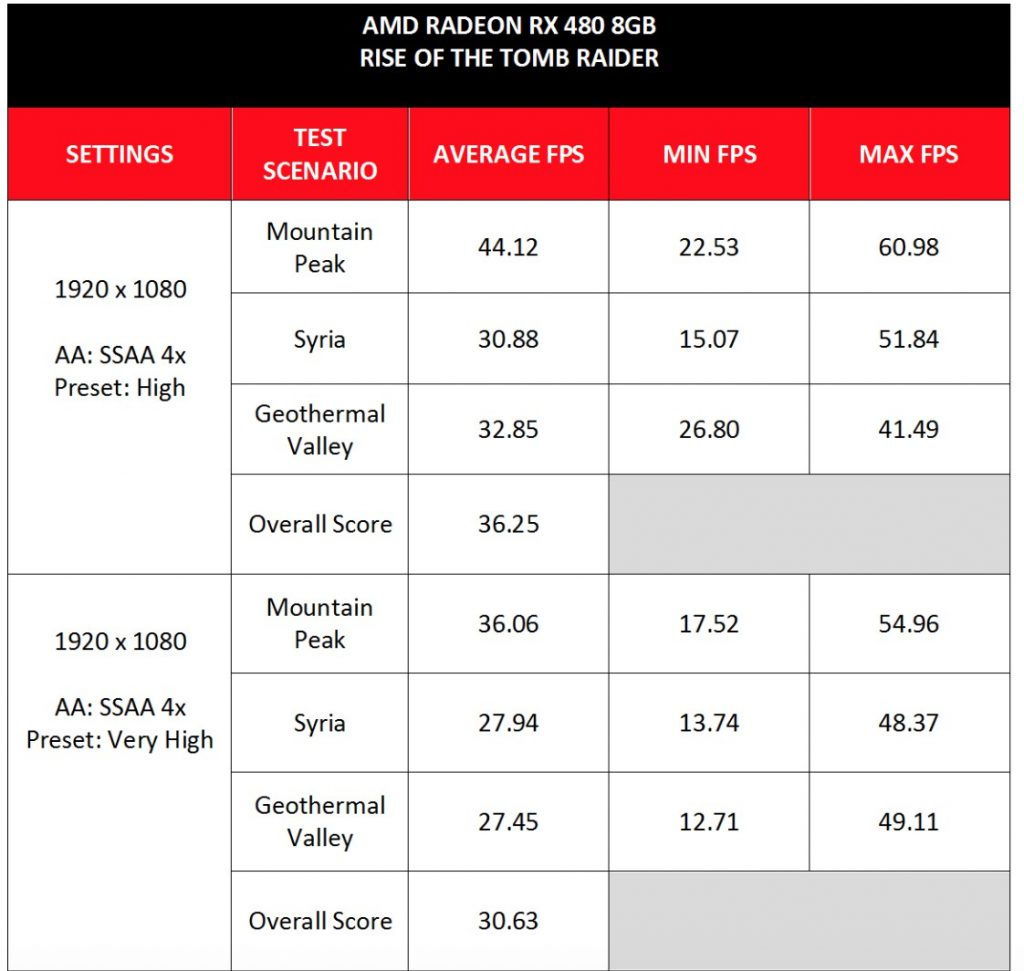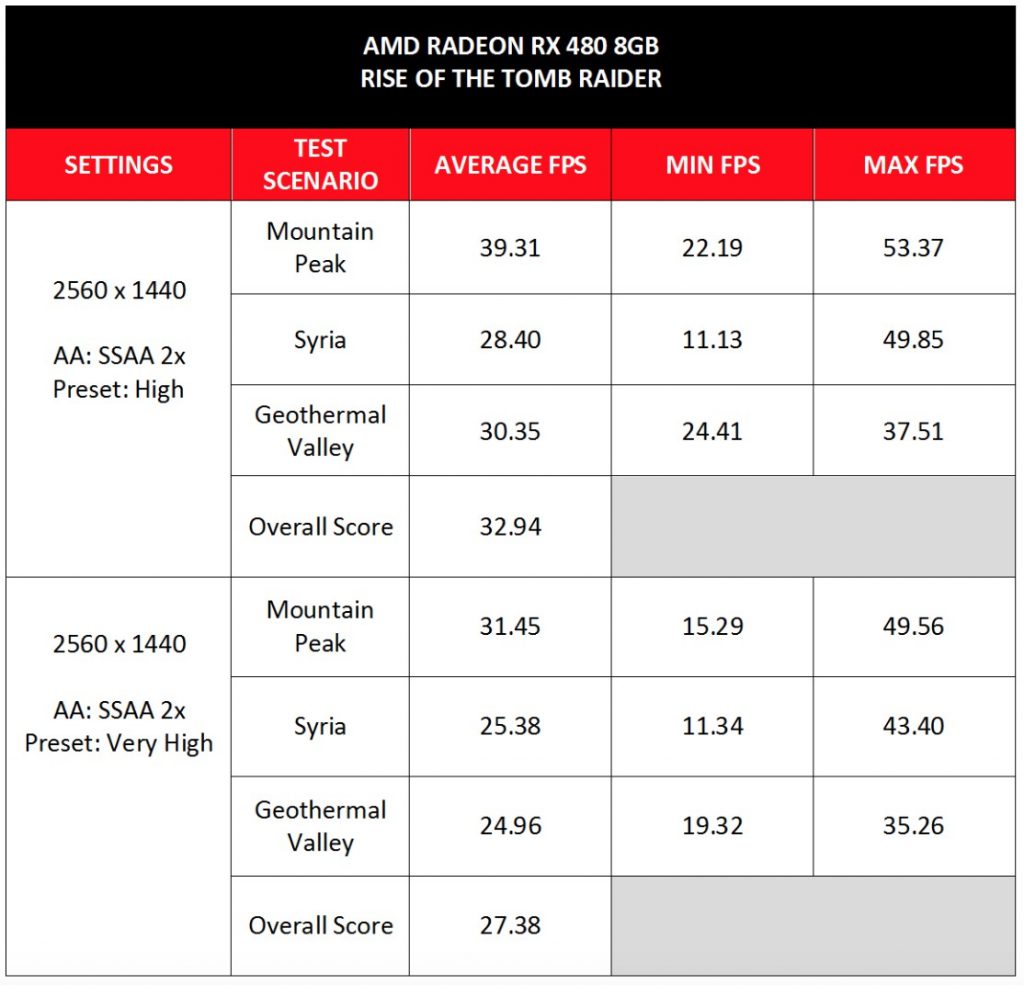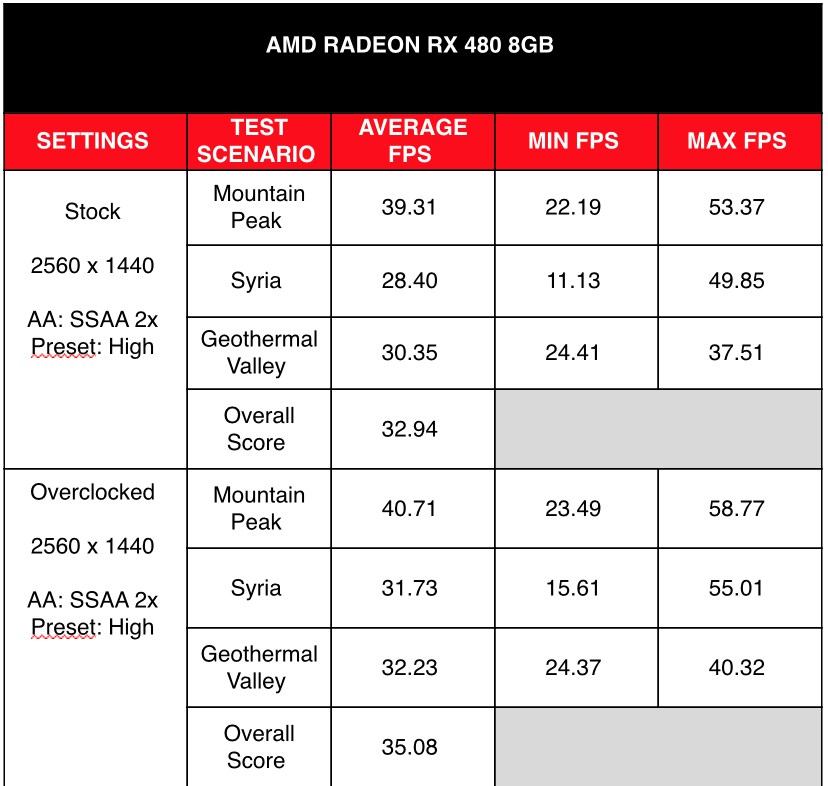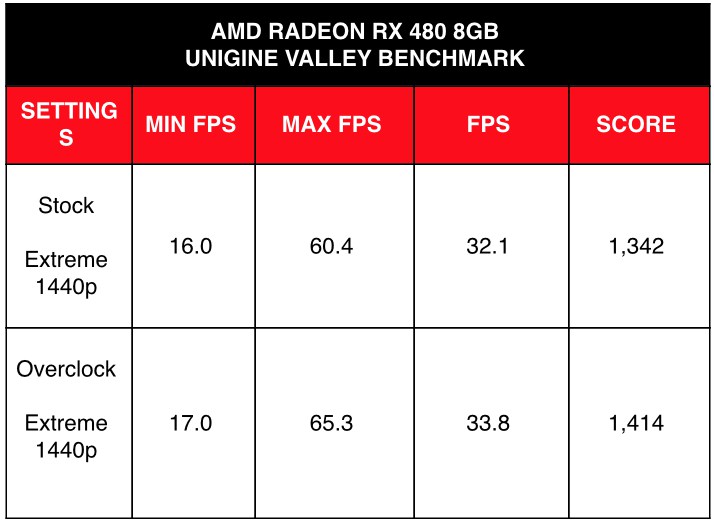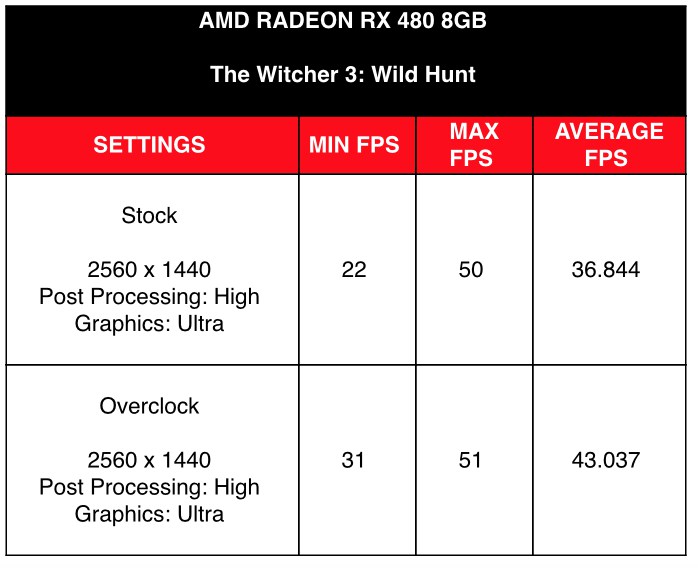Towards the end of last month, a week before the world got to see AMD’s newest offering, I was at a Radeon press event in Macau (dubbed as “Polaris Tech Day”), expecting to see AMD’s answer to Nvidia’s jaw-dropping GTX 1080 and GTX 1070 graphics cards. The night before the unveiling, I heard a few whispers floating around saying that AMD will be releasing a mid-range graphics card, not a high-end one; and I kid you not, I thought to myself if that were to happen, AMD will be shooting themselves in the foot.
It happened
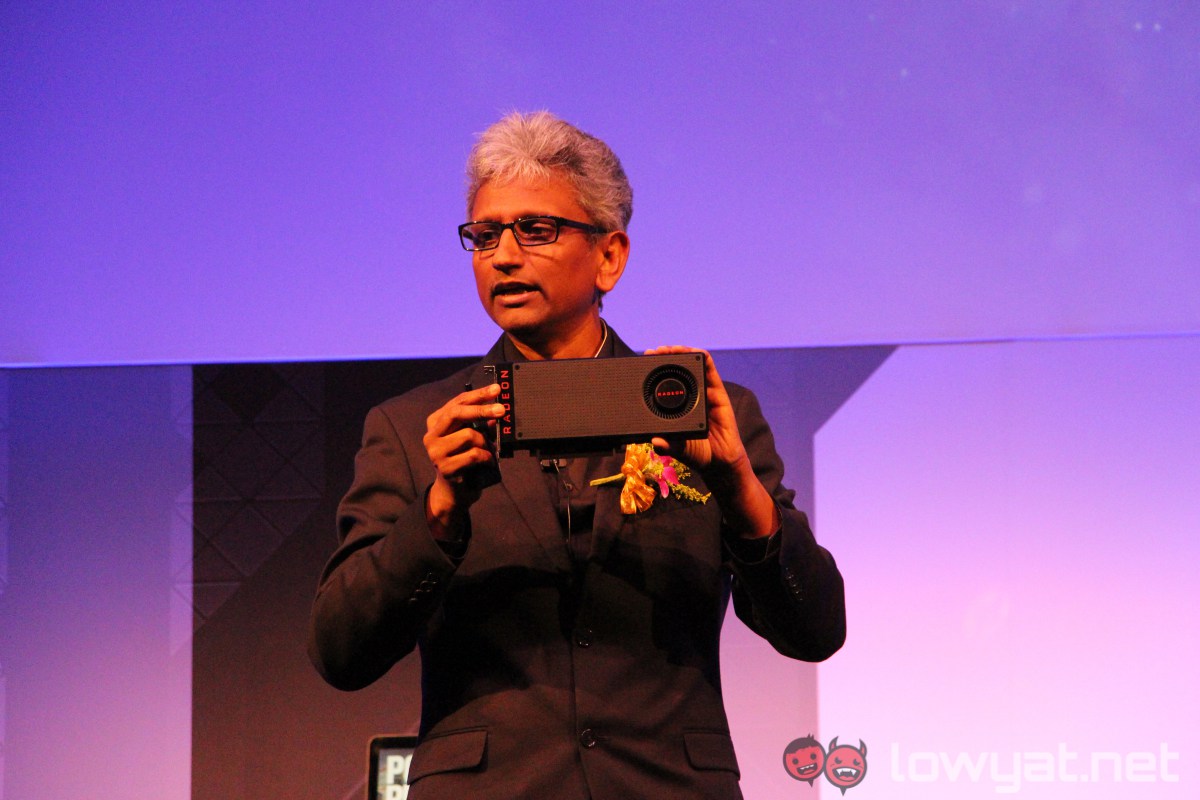
The following morning Raja Koduri, head of Radeon Technologies Group stood on stage to unveil a mid-range graphics card in front of a sea of journalists and industry experts; and it was called the Radeon RX 480. The graphics card was made for mainstream gamers, which apparently represents about 80% of the PC gaming community. Then it struck me: to cater for that large group of gamers will definitely help AMD to regain the GPU market share from Nvidia. Not to mention the fact that this graphics card was also supposedly made to bring VR gaming to more gamers too.
But of course, everything that was said during that lengthy press event remained something that had to be proven. Fast forward a few weeks from that day and here we are, ready to present to you the results of our benchmarking run with the Radeon RX 480. So let’s see how that turned out, shall we?
Polaris 10
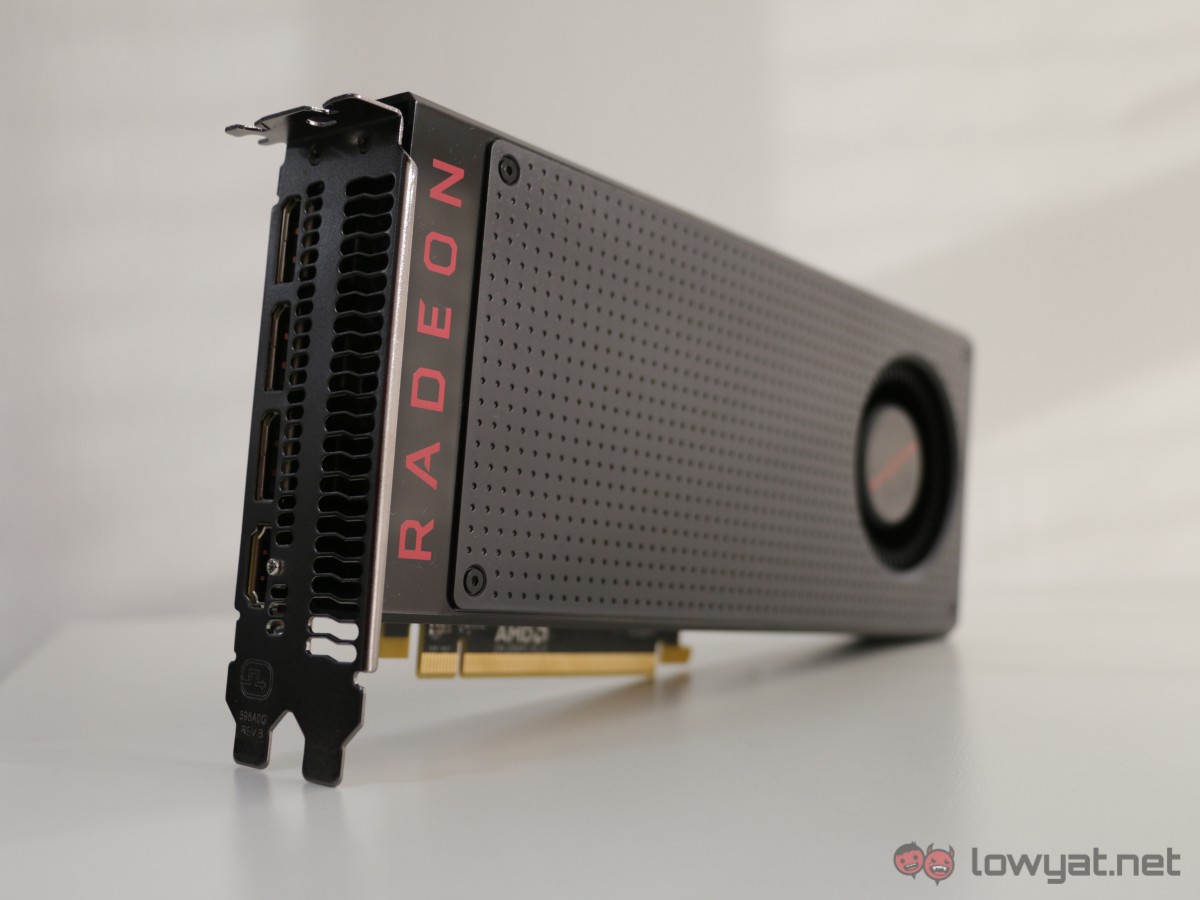
Now, before we get started, let’s talk about the heart of the Radeon RX 480: the Polaris 10 GPU. Radeon’s 14nm Polaris 10 GPU comes with 36 Compute Units or 2304 Stream Processors. In addition, Radeon’s newest GPU has a single-precision floating point performance (FP32) of more than 5 TFLOPS. Besides that, the Polaris 10 GPU also has a base clock speed of 1,266MHz along with a memory bit-rate of 265-bit. It supports new display outputs such as DisplayPort 1.3 and 1.4 for HDR as well as HDMI 2.0b.
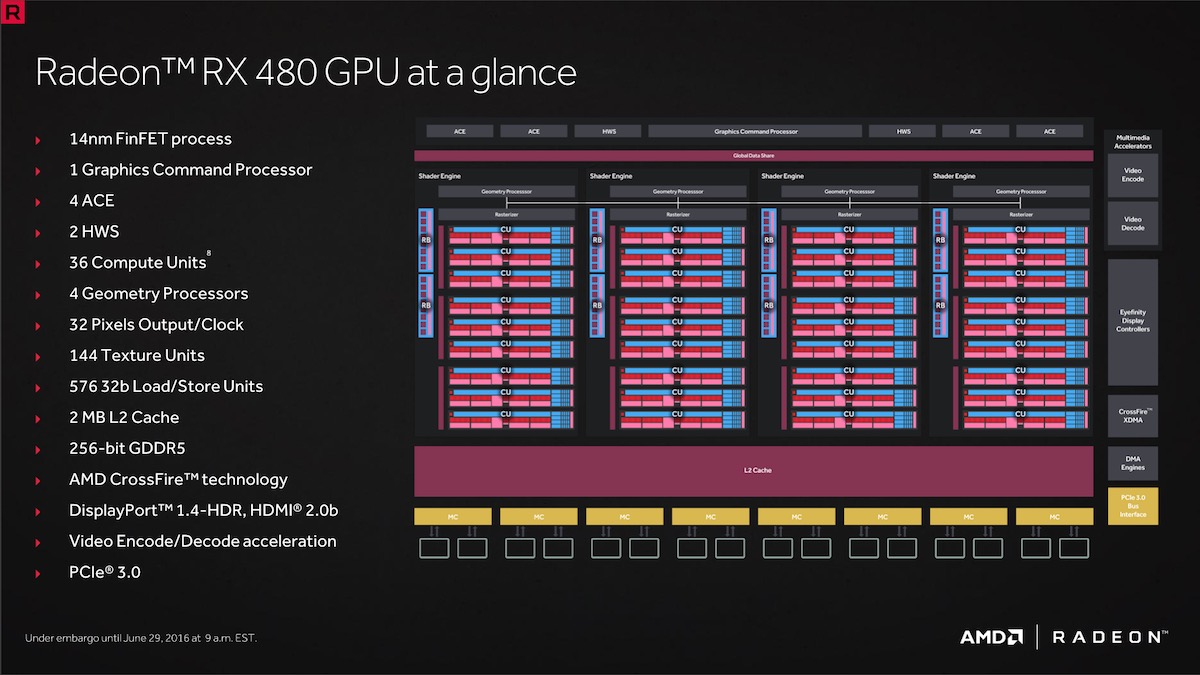
Looking at the specifications of Radeon’s Polaris 10 GPU, it seems to be a far cry of what its previous Fiji XT GPU is capable of doing. However, one has to remember (again) that Radeon is aiming for the mid-range market with its Polaris GPUs; which means that there is no need to manufacture a GPU that rivals the Fiji XT in terms of performance – because gamers in the mainstream market rarely need that kind of graphics processing power anyway.
Test Bench and Graphics Card Specifications
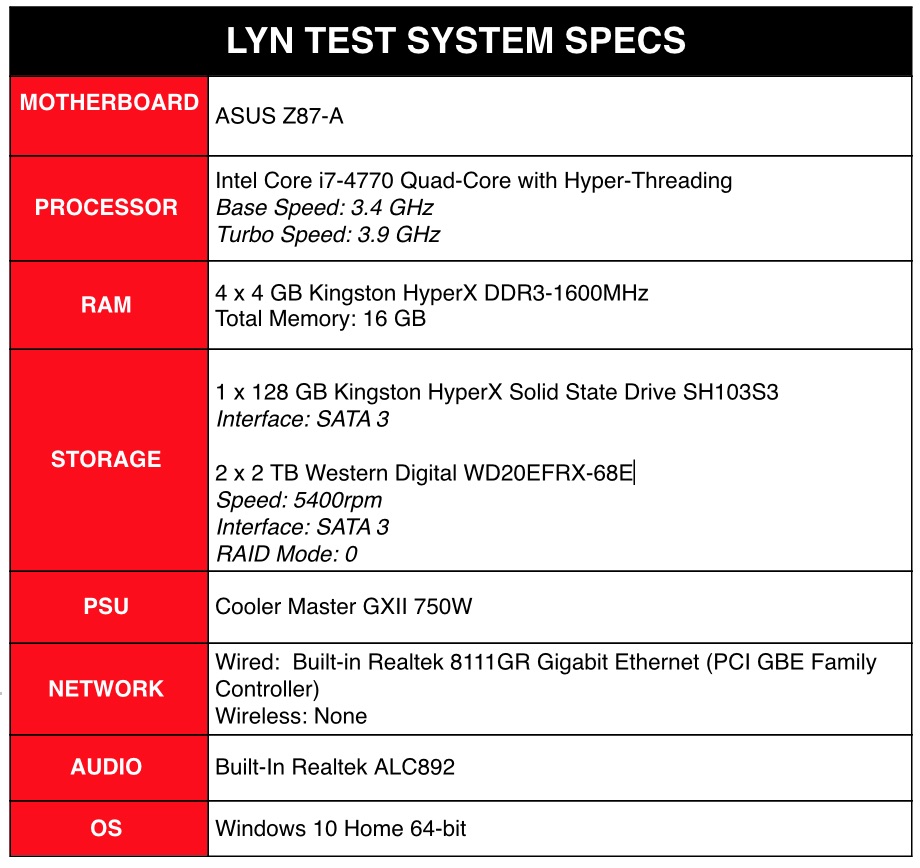 *The display used in this review is the 28-inch Acer Predator XB281HK 4K Gaming Monitor.
*The display used in this review is the 28-inch Acer Predator XB281HK 4K Gaming Monitor.
Benchmark Results
3DMark Fire Strike
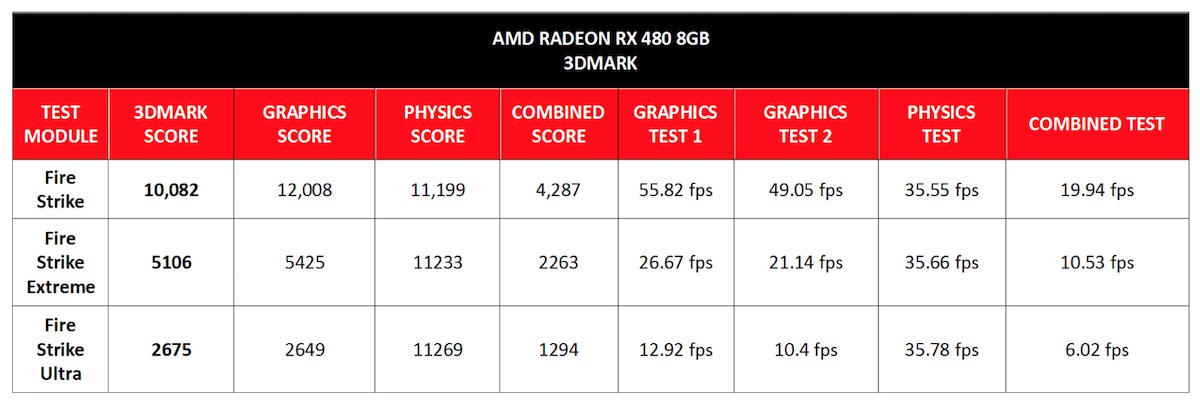
Radeon’s RX 480 churned out impressive 3DMark Fire Strike scores… well, for a graphics card of its price, of course. It’s worth mentioning that the one particular score that one has to pay close attention to is the graphics score – because it isn’t greatly influenced by the performance of the CPU. That aside, on the Fire Strike test, the RX 480 managed to rack up a graphics score of 12,008. Meanwhile, on the much more demanding Fire Strike Extreme and Ultra tests, the Radeon graphics had a respectable graphics score of 5,425 and 2,649 respectively.
The reason why I’ve said this graphics card had “respectable” graphics scores is because they are on-par with that of Nvidia’s GeForce GTX 970 graphics card; which had graphics scores on the Fire Strike and Fire Strike Extreme tests of around 11,691 and 5,472 respectively. The same can also be said when the Radeon RX 480 was compared to the R9 380X.
Unigine Valley
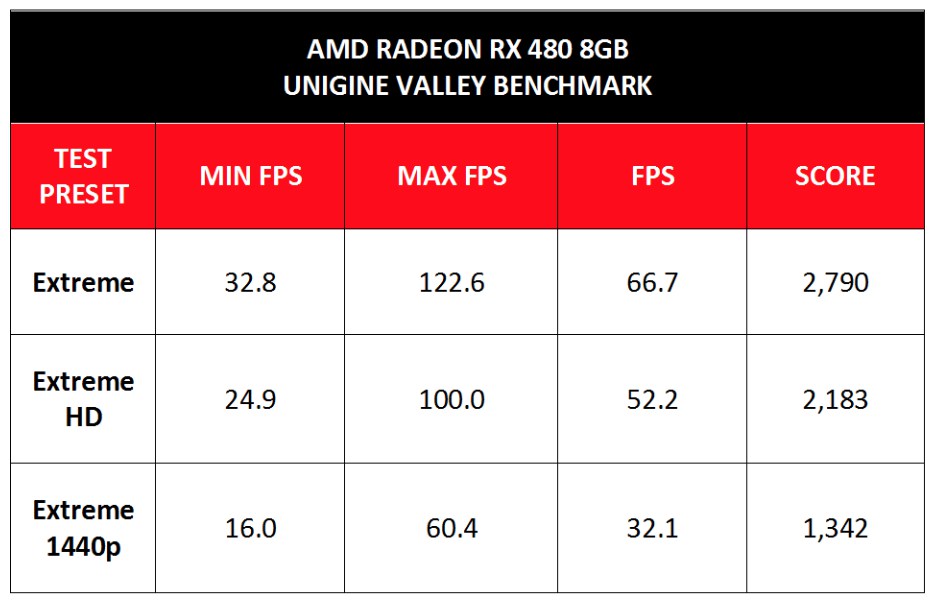
Aside from 3DMark, another synthetic test that the Radeon RX 480 performs well in is the Unigine Valley series of benchmarks. In the Extreme test preset, the RX 480 had an overall score of 2,790. Following that, the graphics card had an Extreme HD and Extreme 1440p test preset scores of 2,183 and 1,342 respectively. When it comes to frames per second (in this test), the RX 480 managed to sustain more than 50fps while on the 1080p resolution, while falling to the low 30fps on 1440p.
Steam VR Test
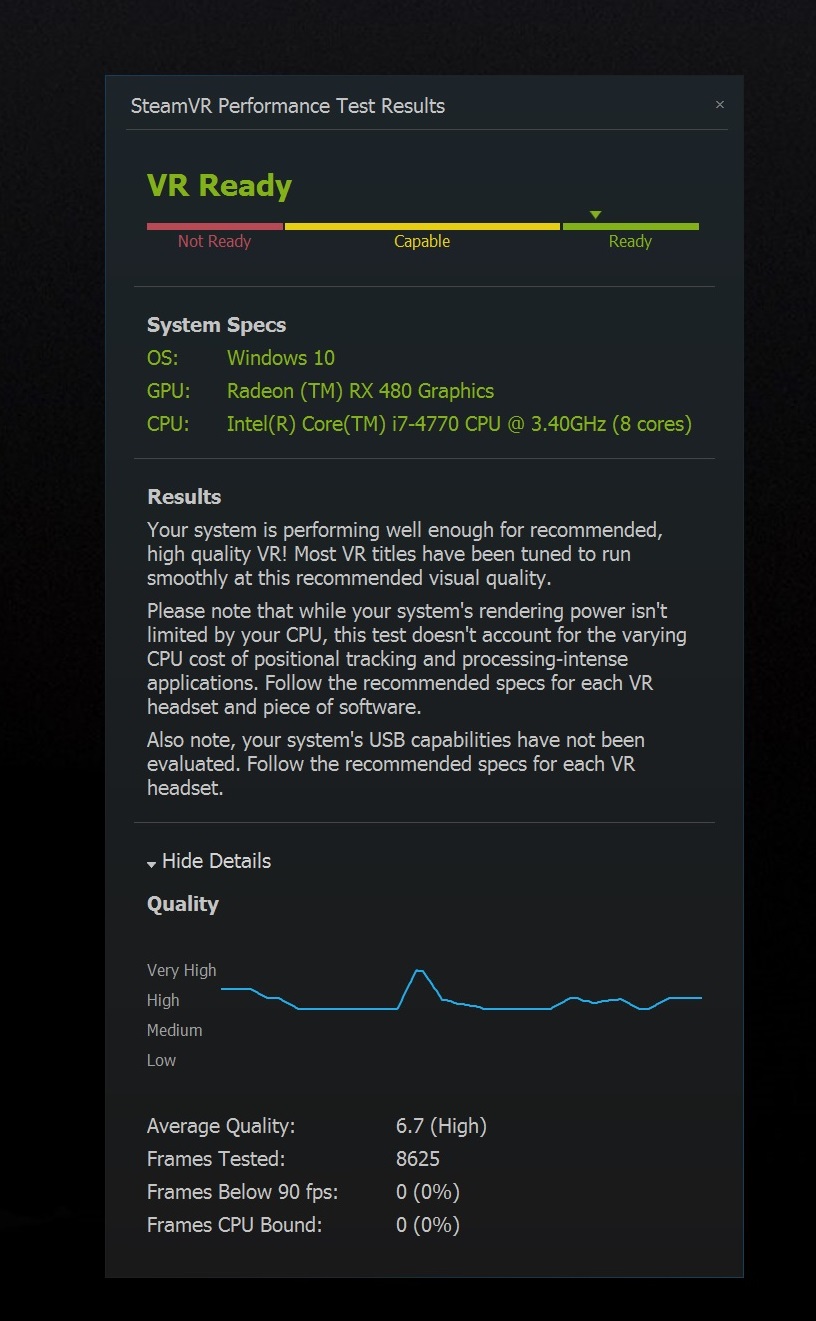
Gaming: Non-overclocked
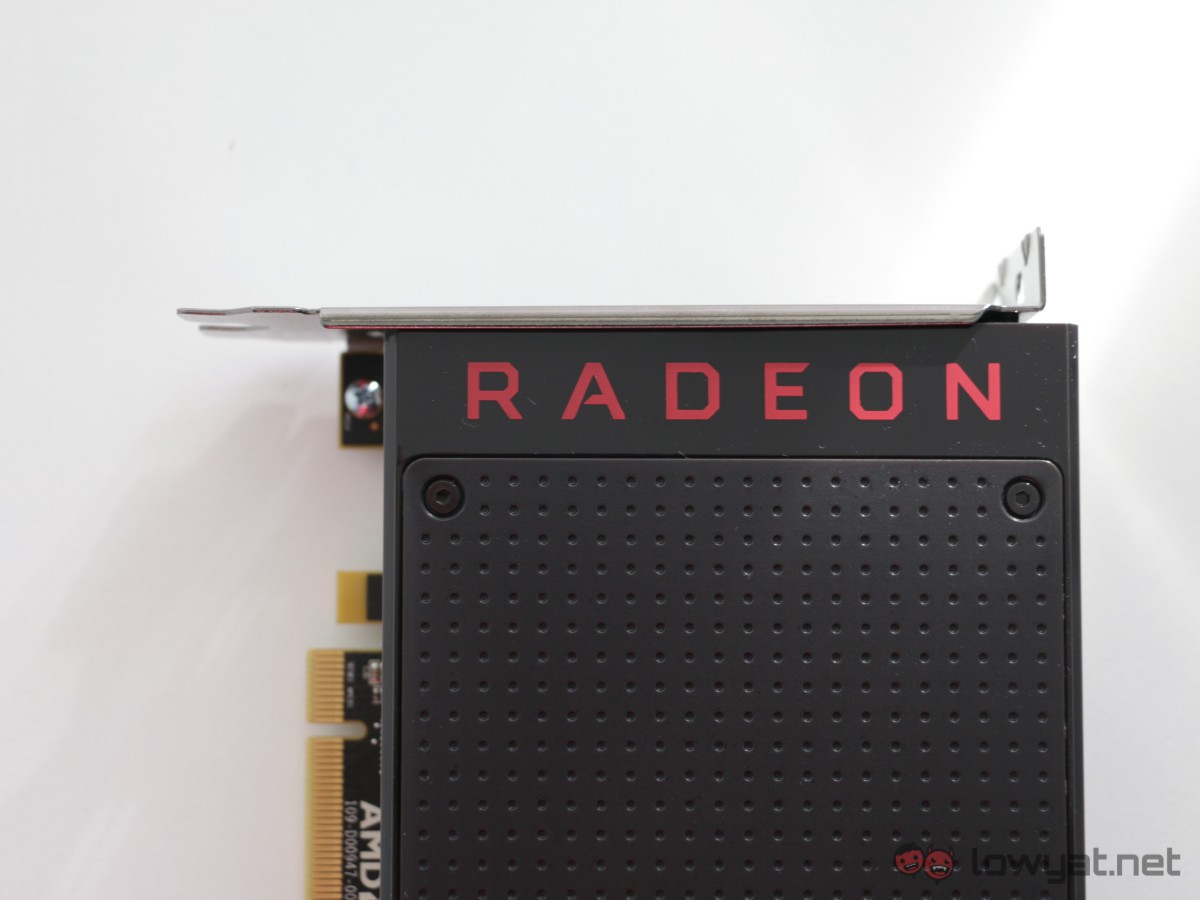
Synthetic benchmarks can only say so much about the capabilities of a graphics card. To see how the Radeon RX 480 performs in the real world, it has to be tested on multiple games. The games used to benchmark this graphics card range from those that use one of two major APIs: DirectX 11 and DirectX 12. It’s worth mentioning that all of the games tested in this review have their settings set to the highest, unless stated otherwise.
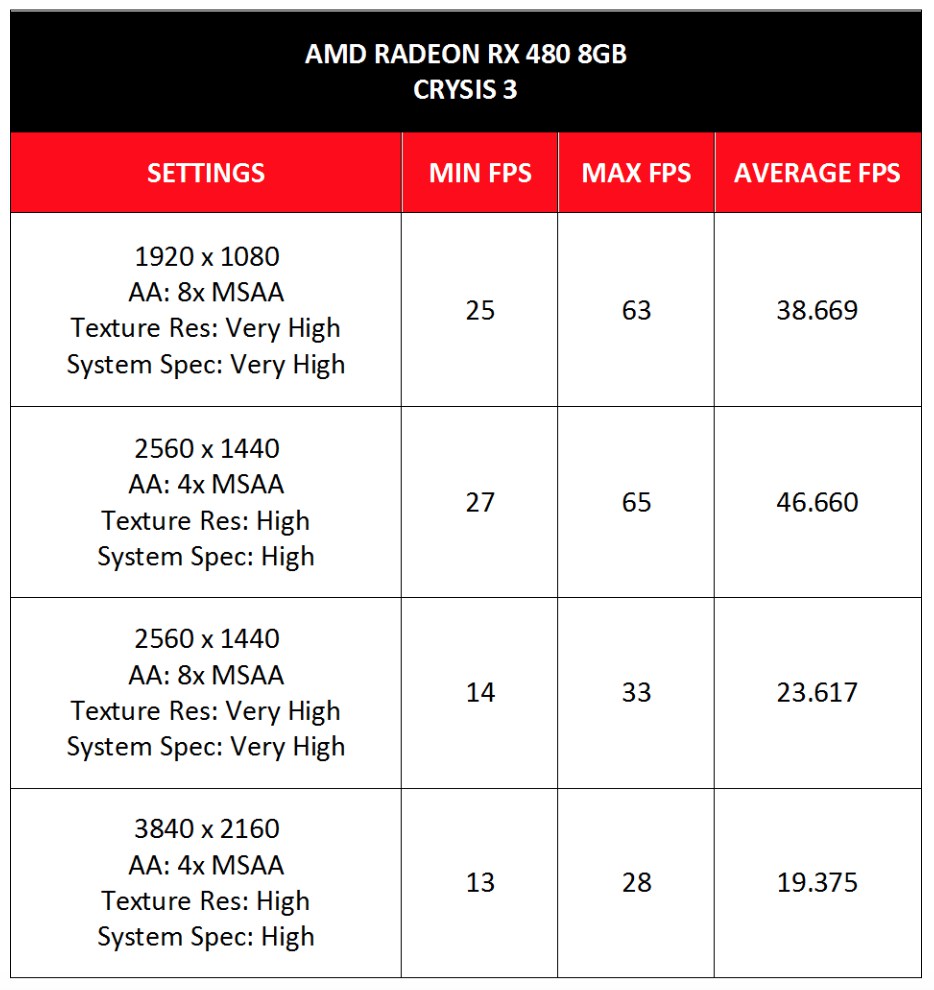
DirectX 11 games such as Battlefield 4 and Crysis 3 ran at framerates above 30 when played at a resolution of 1920 x 1080. To be more specific, Crysis 3, being a very demanding game had the Radeon RX 480 averaging 38.7fps at 1080p with the settings cranked up to max (Very High, 8x MSAA). Unfortunately, once the settings were set to Very High at 1440p and High at 4K, the game started to churn out framerates below 30, which I would deem as: unplayable.
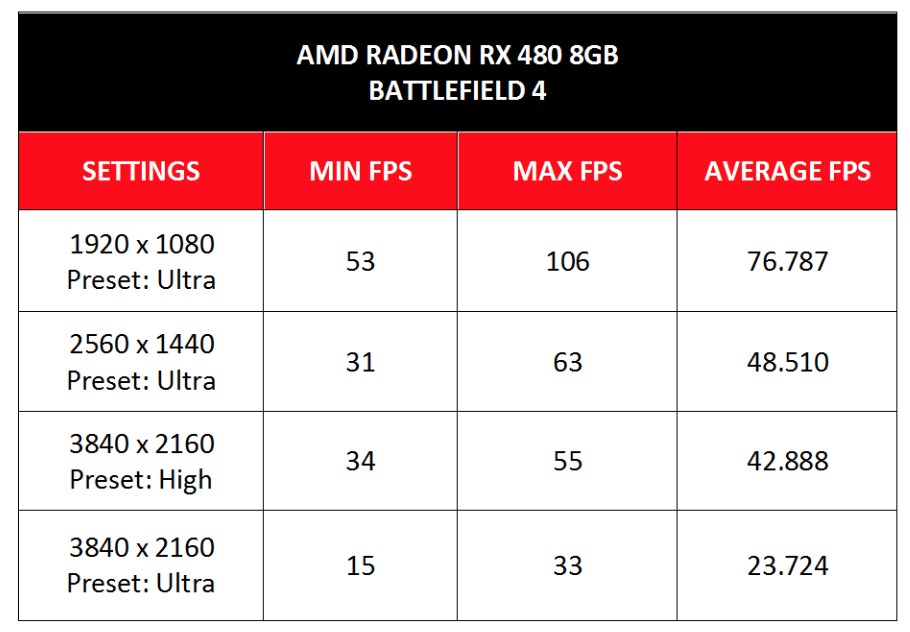
However, things started to look better when the RX 480 was running Battlefield 4. Interestingly, the graphics card managed to produce above 40fps when played at 1080p and 1440p (both on Ultra preset) and 4K (High preset).

DirectX 12 is supposedly where AMD’s graphics cards will start to shine; and the Radeon RX 480 did just that when tested with the Hitman (2016) game. On all major gaming resolutions, the graphics card had frames per second of 30 with settings almost cranked up to the max.
However, the same level of performance couldn’t entirely be replicated when running Rise Of The Tomb Raider. At High (4x SSAA) graphics preset, the graphics card only managed to produce an overall framerate score of 36.3; which is rather surprising. The same can also be said when the game was played at 1440p and 4K resolution, both producing sub-30fps gameplay.
Gaming: Overclocked
Radeon came up with a very interesting GPU utility that comes built in with its Radeon Software Crimson Edition driver. Amusingly, the utility is dubbed as the Radeon “Wattman” and according to the company, this utility was created to encourage overclocking and make it easy to do so on a Radeon GPU. Here’s what it looks like:
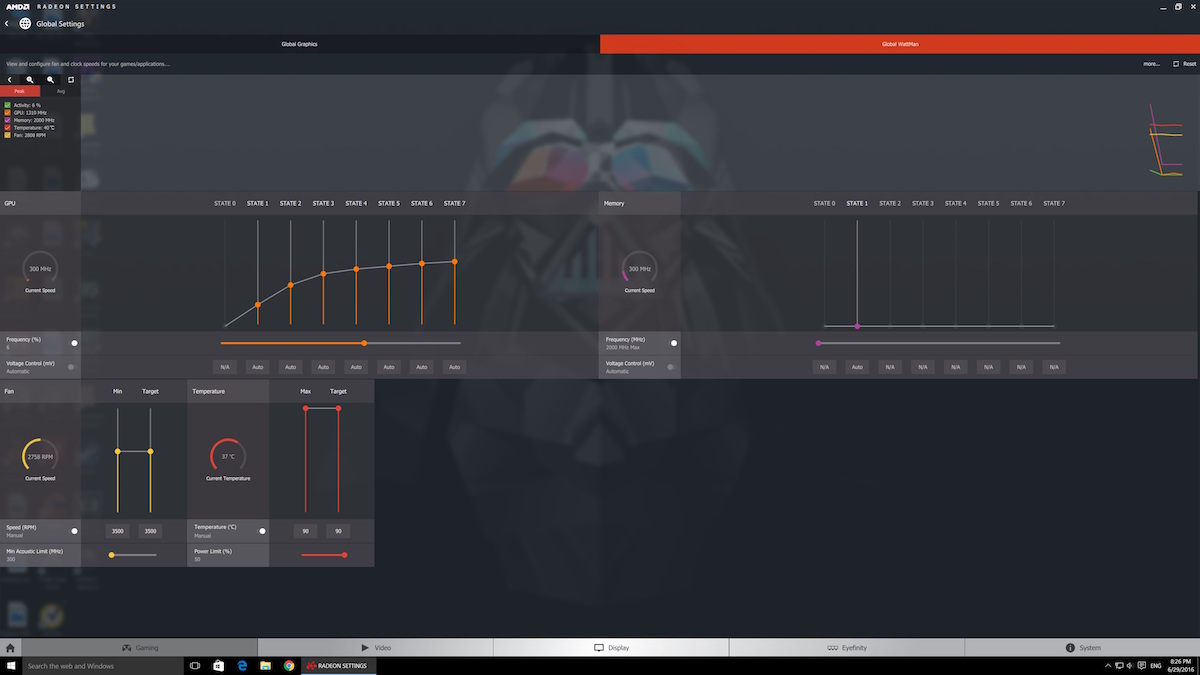
Initially, we were able to achieve clock speed of 1,355 MHz and 2,075 MHz for GPU and memory clock respectively using the Radeon Wattman. This was achieved with default presets on the temperature and fan settings. However, whilst doing so, the card oddly downclocked itself when benched with certain games. This forced us to make some changes as listed below:
- Increased Temperature limit to 90C
- Increased Power Limit to 50%
- Increased Fan Speed limit to 3500 RPM
- Lowered Min Acoustic Limit to 300 MHz
After we implemented said settings, the Radeon RX 480 was able to run at a stable clock speed of 1,340 MHz with no changes being made to the memory clock.
That aside, on the synthetic Unigine Valley benchmarks, the RX 410 managed to attain a score of 1,414 after being overclocked; which translates to an increase in score of 72. Games such as Rise Of The Tomb Raider and Witcher 3 had an increase in overall framerate output of 2.14fps and 6.2fps respectively – both games ran at a resolution of 1440p.
Temperature/Power Draw/Noise Output
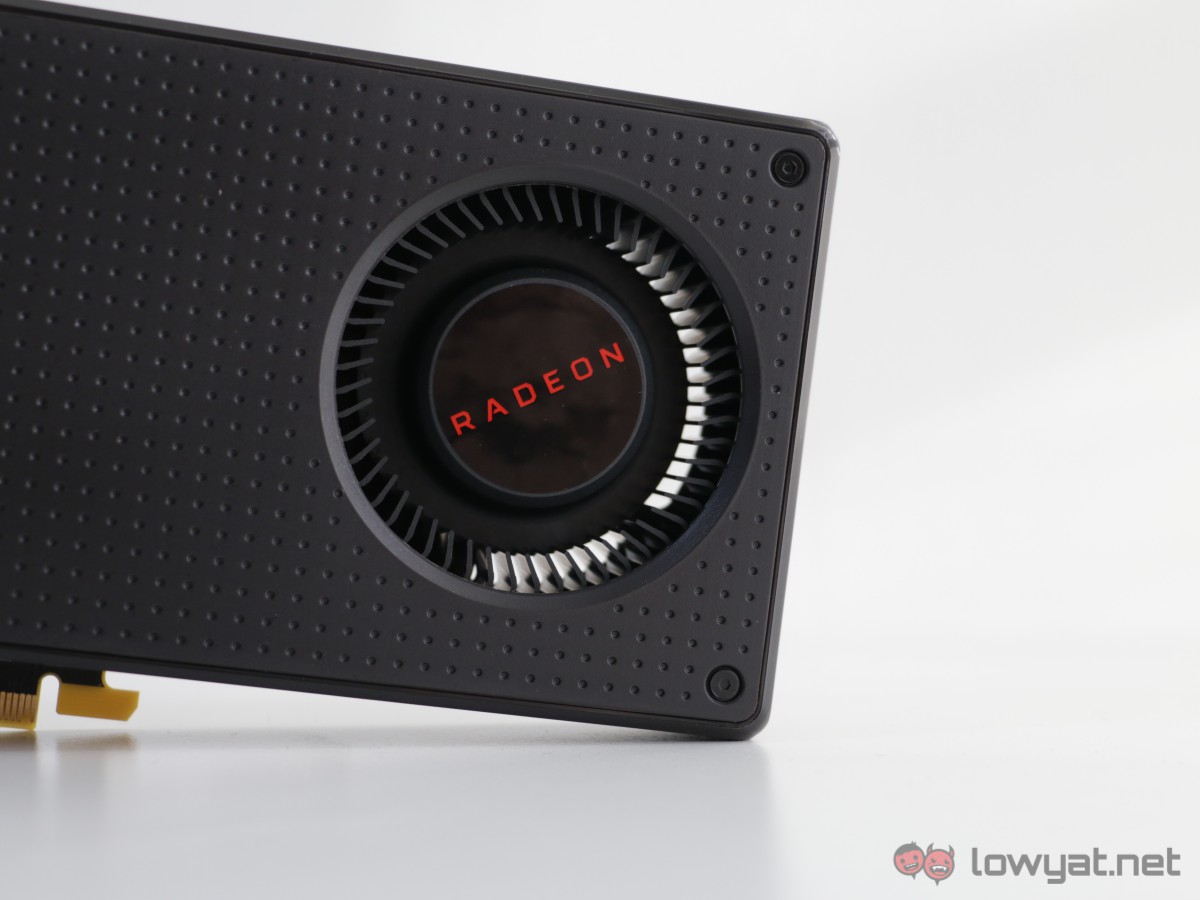
What makes a graphics card appealing is not only its performance, but also its power efficiency. On stock settings, the RX 480 consumed up to 230W of power and about 280W when overclocked. Bear in mind that the power consumption is also greatly influenced by the entire system. If one were to compare the RX 480 against the older Radeon R9 390X, the power draw efficiency of the former graphics card becomes rather apparent.
When it comes to thermals, the Radeon RX 480 gave surprising results. On idle, the graphics card had a “normal” temperature of 36°C. That said, when under full load, the RX 480 produced worrying temperatures of up to 83°C. After the graphic card had its fan speed limit set to 3500rpm and overclocked, the RX 480 had an idle temperature of 29°C and 79°C under load.
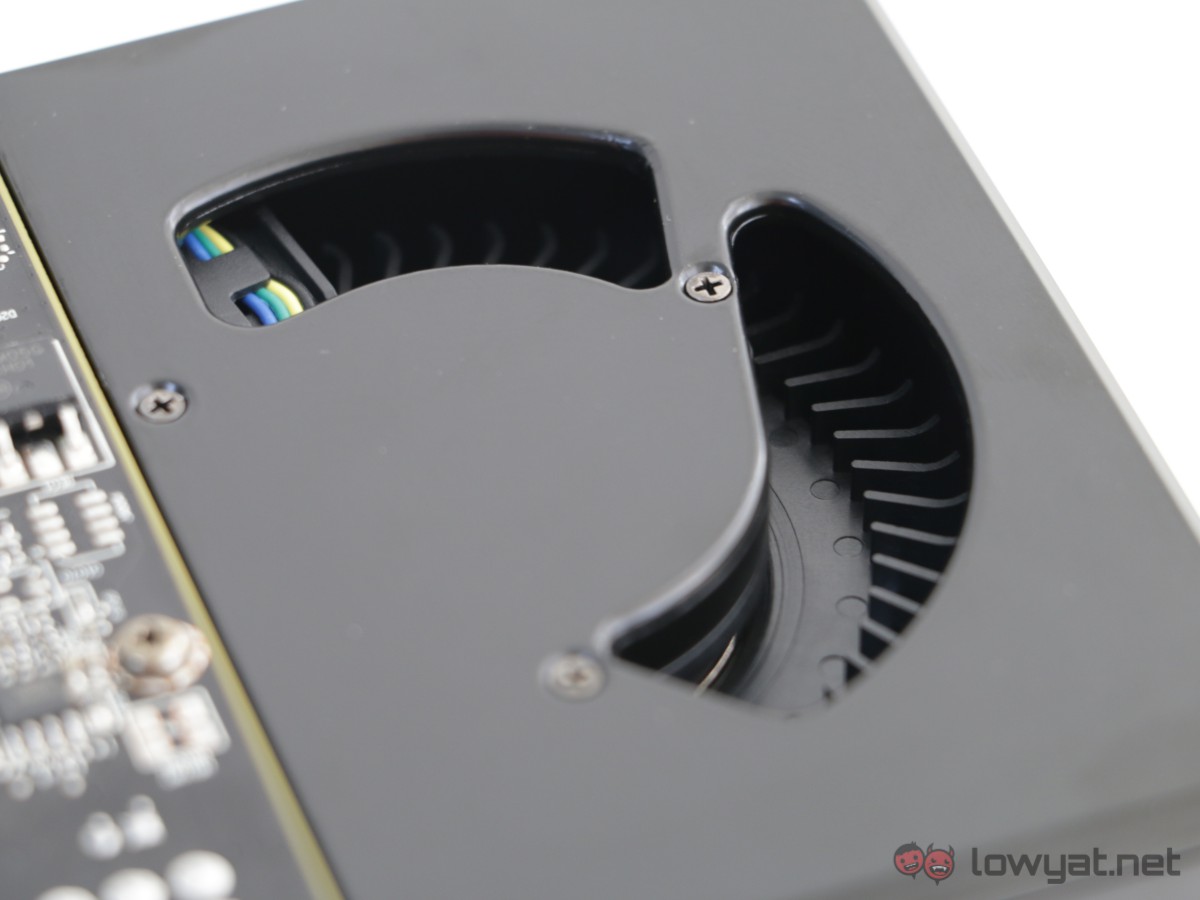
Not forgetting the noise output of the RX 480. As one would expect with modern graphics cards nowadays, the fan noise can barely be heard when on idle. The same can be said about the RX 480 when under load, producing relatively faint buzzing noises from its blower-style fan. Unsurprisingly, after being overclocked, the noise output from the RX 480 becomes rather audible when the fan speed was at ~2750rpm. Speaking of which, the fan speed of this graphics card can be altered up to 5200rpm using Radeon’s WattMan tool.
Design
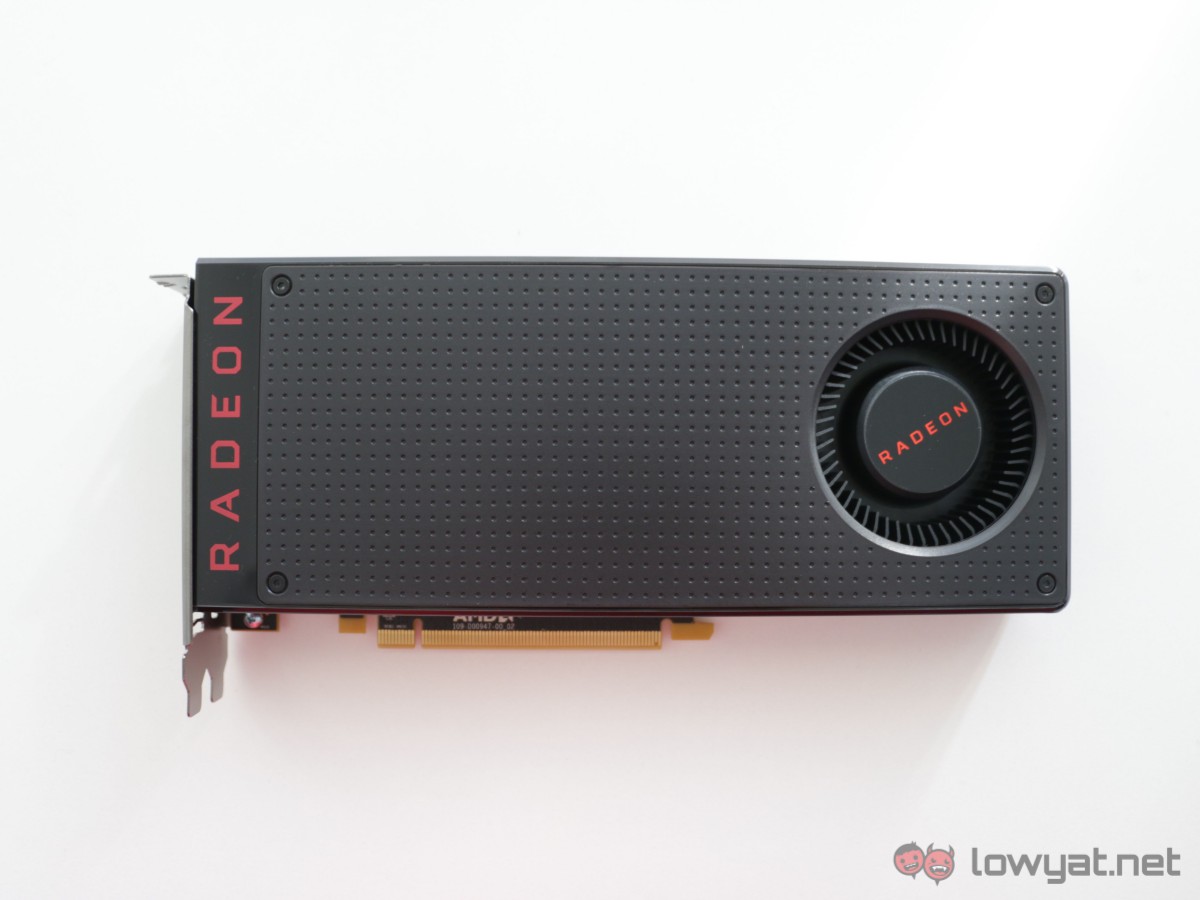
The design that Radeon has incorporated with the RX 480 is, well, same as any other reference Radeon graphics cards. That said, the graphics card does come with the company’s “new” font for its logo. That aside, like reference Radeon cards before it, the RX 480 is murdered-out in a matte black finish. The Radeon logo surrounding the graphics card is displayed boldly in “AMD Red”, of course.
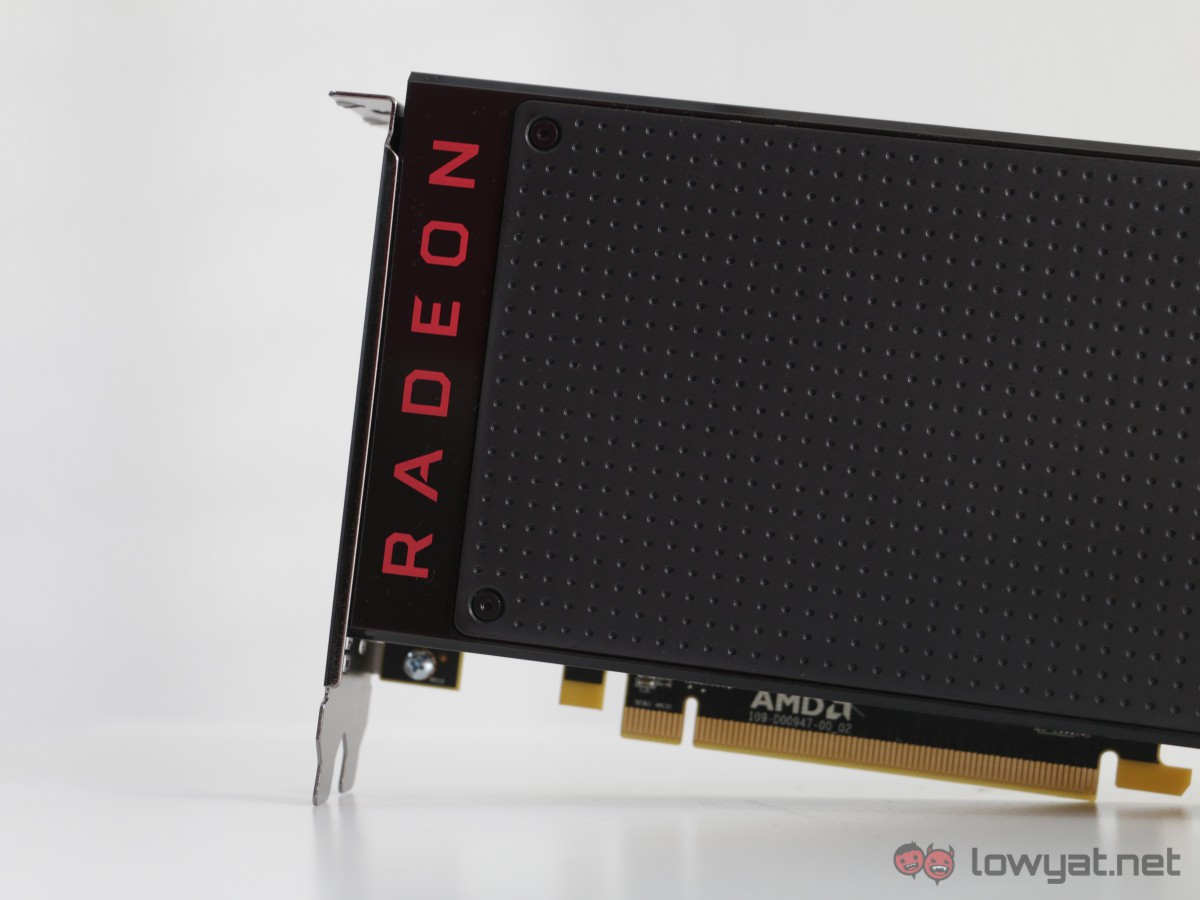
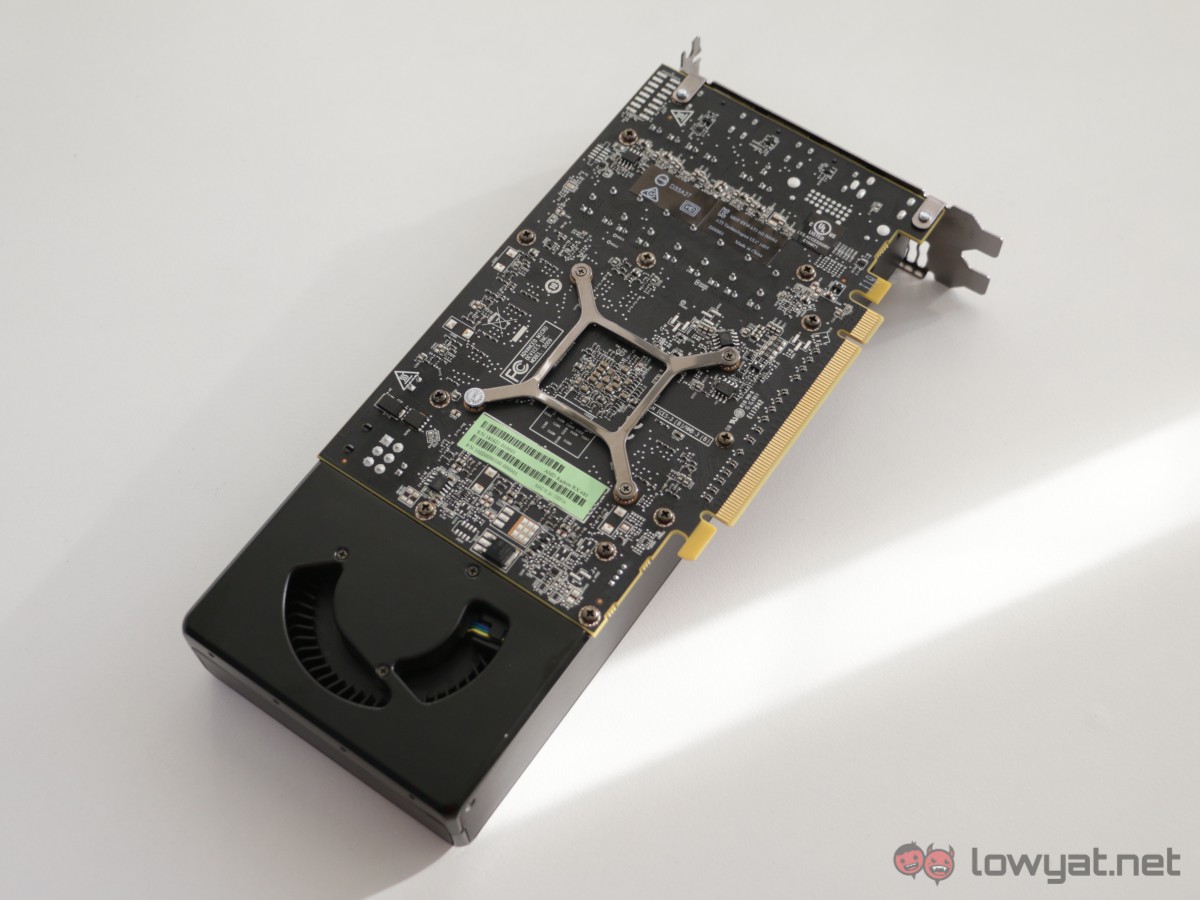
The reference RX 480 that’s designed by Radeon comes without a backplate – something that AIB partners should be adding in their custom RX 480s upon release. Radeon decided to stick with a blower-style fan with the RX 480, which can be deemed as sufficient for a graphics card of this calibre.
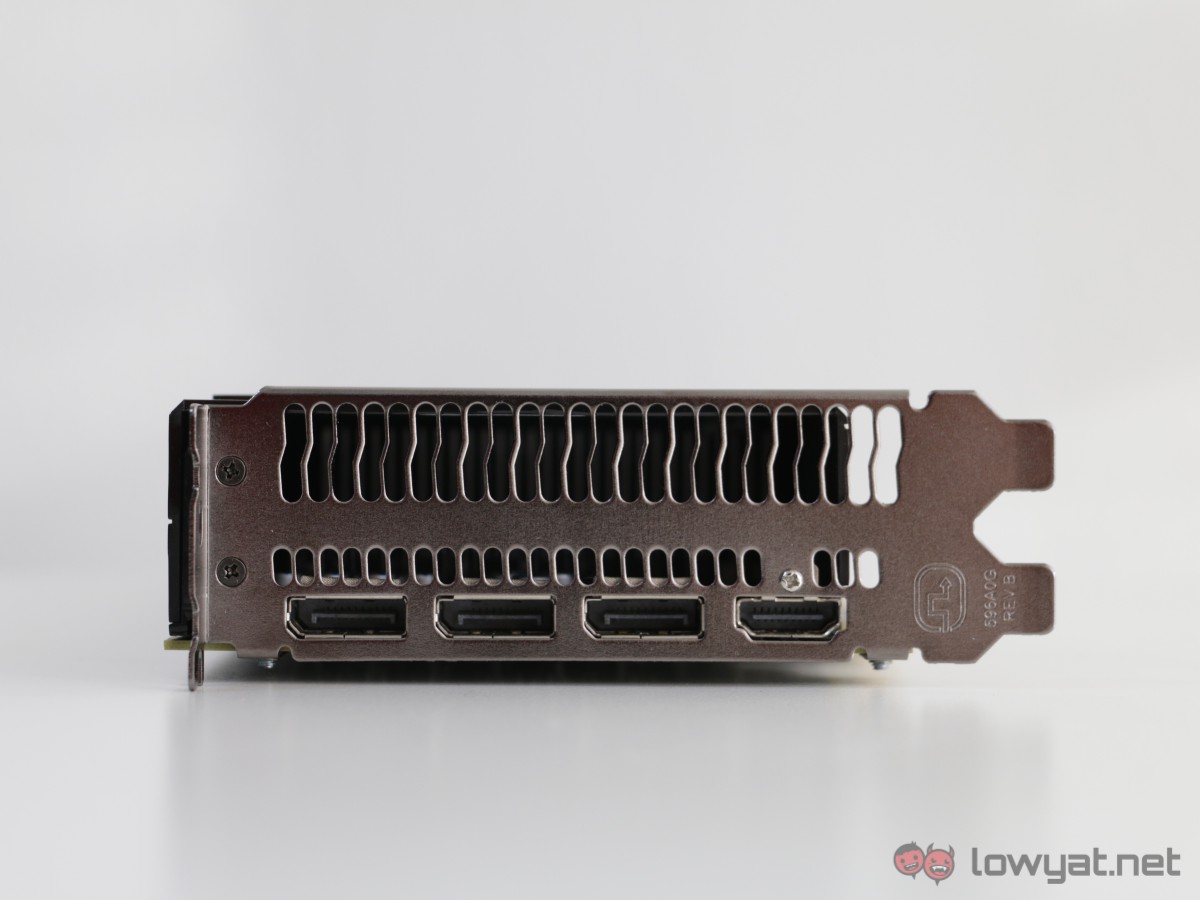
The only odd feature of this graphics card is the fact that it does not come with a DVI-D port. Instead, the RX 480 is equipped with one HDMI port and four DisplayPort..ports. Lastly, all one needs to power this graphics card is a single 6-pin power connector.
Competition
Nvidia GeForce GTX 970
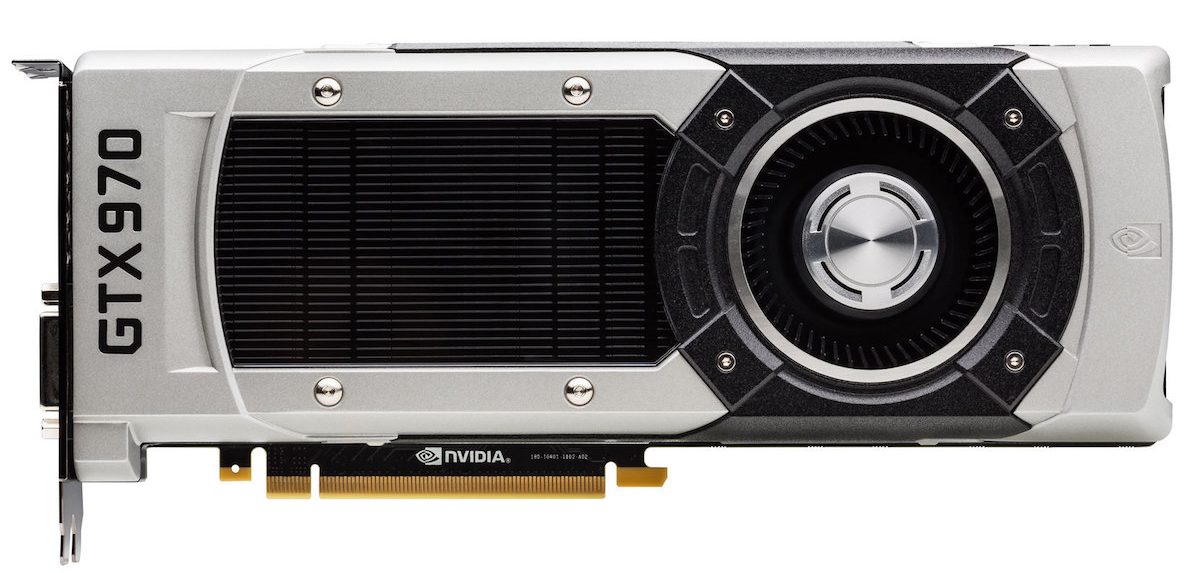
Ah, who could forget the wonderful 3.5GB Nvidia GTX 970. As it stands, this is one of the most popular graphics card used amongst PC gamers on Steam, which goes to show how reliable it can be. When compared against the Radeon RX 480, benchmark scores of the GTX 970 can be deemed as “on-par”. Despite bearing a high price tag during launch (~RM1,500), one can easily get a GTX 970 now for less than RM1,200 nowadays (second-hand) – thanks to Nvidia’s new Pascal-based graphics cards. So if you were out looking for a graphics card that’s almost as powerful and slightly less expensive than the Radeon RX 480, the GTX 970 would be the card to get.
Radeon R9 380X
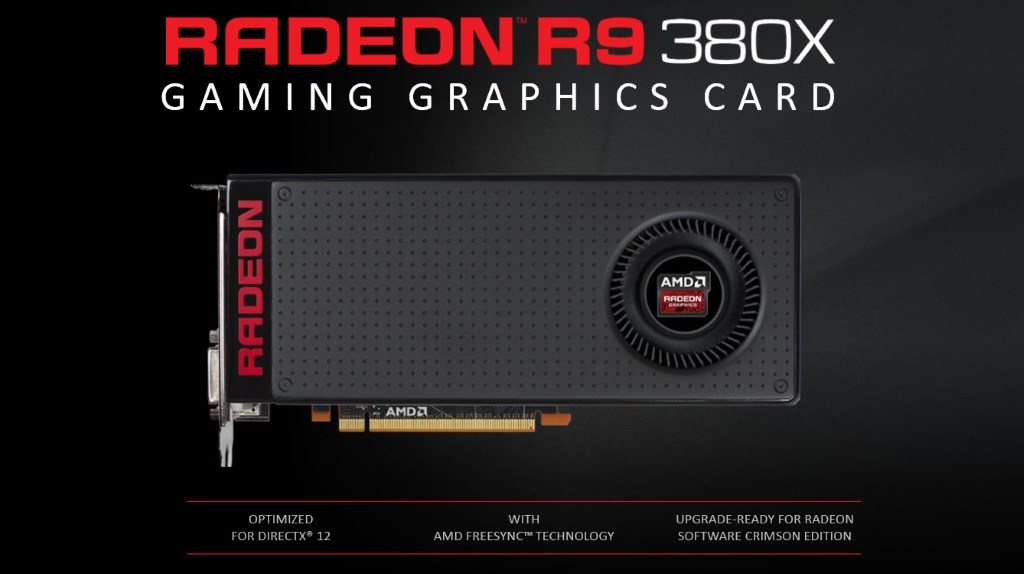
The Radeon R9 380X is for PC gamers who do not look to play graphic intensive games at resolutions higher than 1080p. Yes, this graphics card boasts significantly lower performance output compared to the RX 480, but for those who game exclusively on 1080p, the R9 380X becomes a very economical choice. The current market price for a Radeon R9 380X graphics card is around RM1,150 brand new; which means that getting a second-hand R9 380X will definitely be cheaper. So again, if you’re a gamer that doesn’t want to game at a higher resolution than 1080p and isn’t keen on playing any games on max settings, the R9 380X may be the better graphics card to get compared to the RX 480 – or you could just get the GTX 960, that works too.
Nvidia GeForce GTX 1070
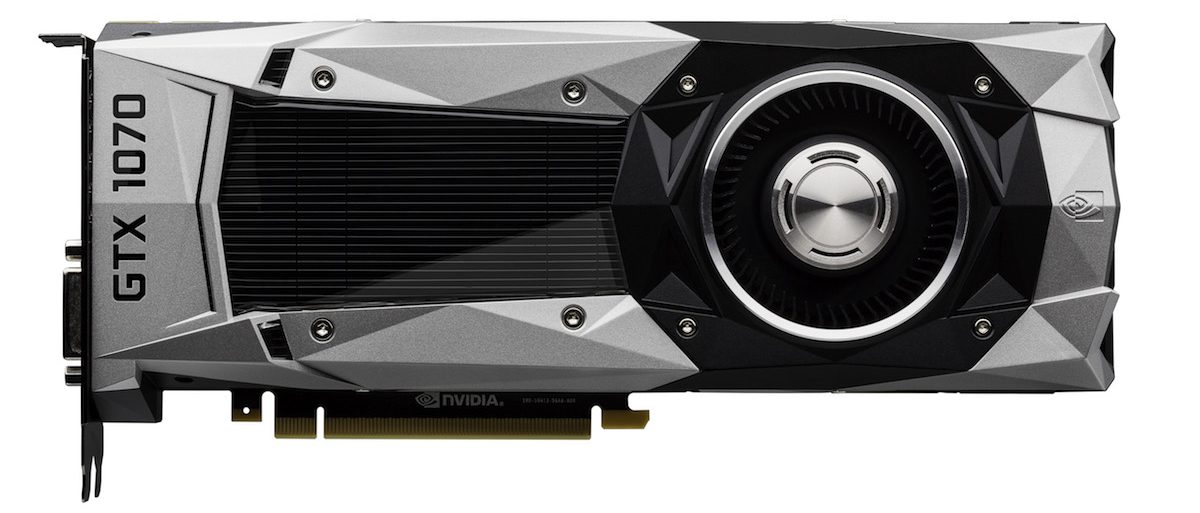
Whilst both graphics cards listed above are mentioned mostly because of their price advantage, the GTX 1070 differs from this category. Equipped with Nvidia’s impressive Pascal GP104-200 GPU, the GTX 1070 has significantly better graphics performance compared to the Radeon RX 480, which is highly unsurprising since it’s a high-end graphics card. In addition, this graphics card is said to boast similar if not better gaming performance compared to the GTX Titan X. PC gamers who want significantly better gaming performance at 1440p without having to shell out tons of money should consider the GTX 1070 over the Radeon RX 480.
Conclusion
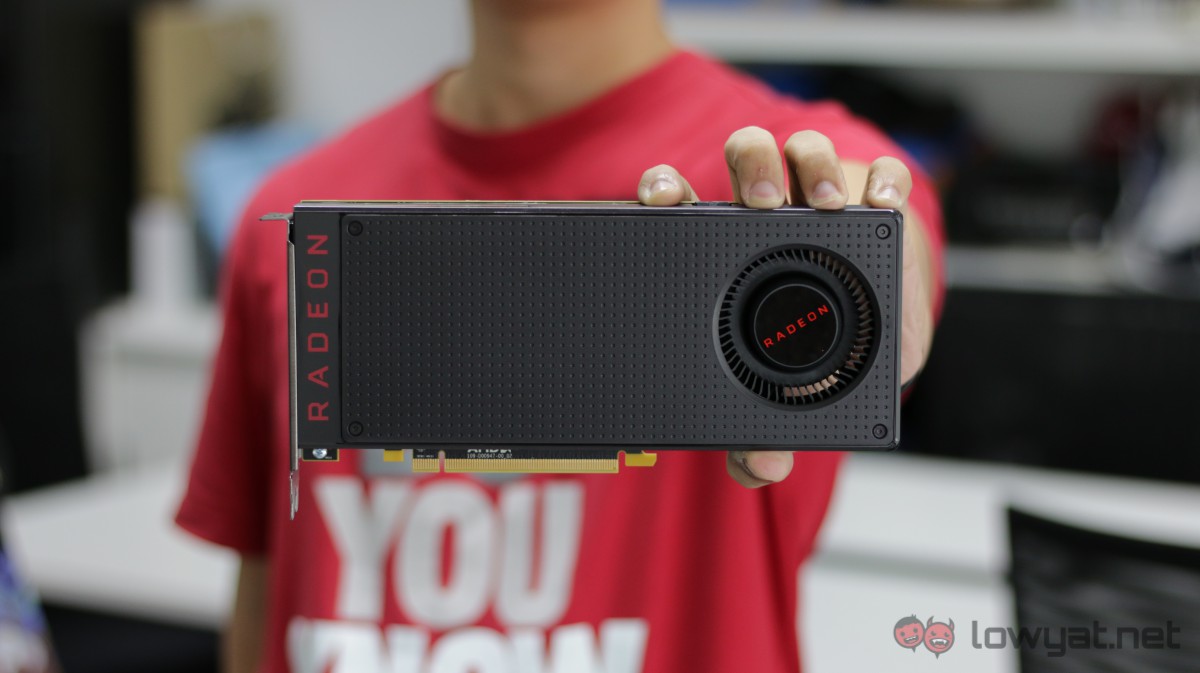
Whilst the RX 480 may not be appealing to hardcore PC gamers and enthusiasts, gamers who look to play games on 1080p and 1440p with playable framerates will find this graphics card rather appealing. Adding to that is the fact that this graphics card only costs merely RM1,299 (8GB variant), which I trust is the sweet spot price for many gamers in Malaysia.
I would definitely recommend the RX 480 to gamers who are looking to upgrade from graphics cards that are two generations behind. However, gamers with GTX 980s, Radeon R9 390X’s and better, may want to reconsider buying this graphics card because… well, as one can see above, the RX 480 doesn’t perform quite as well as those two.

With the RX 480, Radeon is probably sending out a message saying that it’s done chasing after Nvidia in the high-end GPU market. Instead, I believe that the company’s main focus is to try to dominate the mainstream GPU market with mid-range offerings such as the Radeon RX 480 – along with the RX 470 and RX 460.
Follow us on Instagram, Facebook, Twitter or Telegram for more updates and breaking news.

